Are ‘superfoods’ really so super? Teach article
Are you tempted to buy ‘superfoods’ for health reasons, despite the higher prices? These activities encourage students to explore some of the claims made for these celebrity foods.
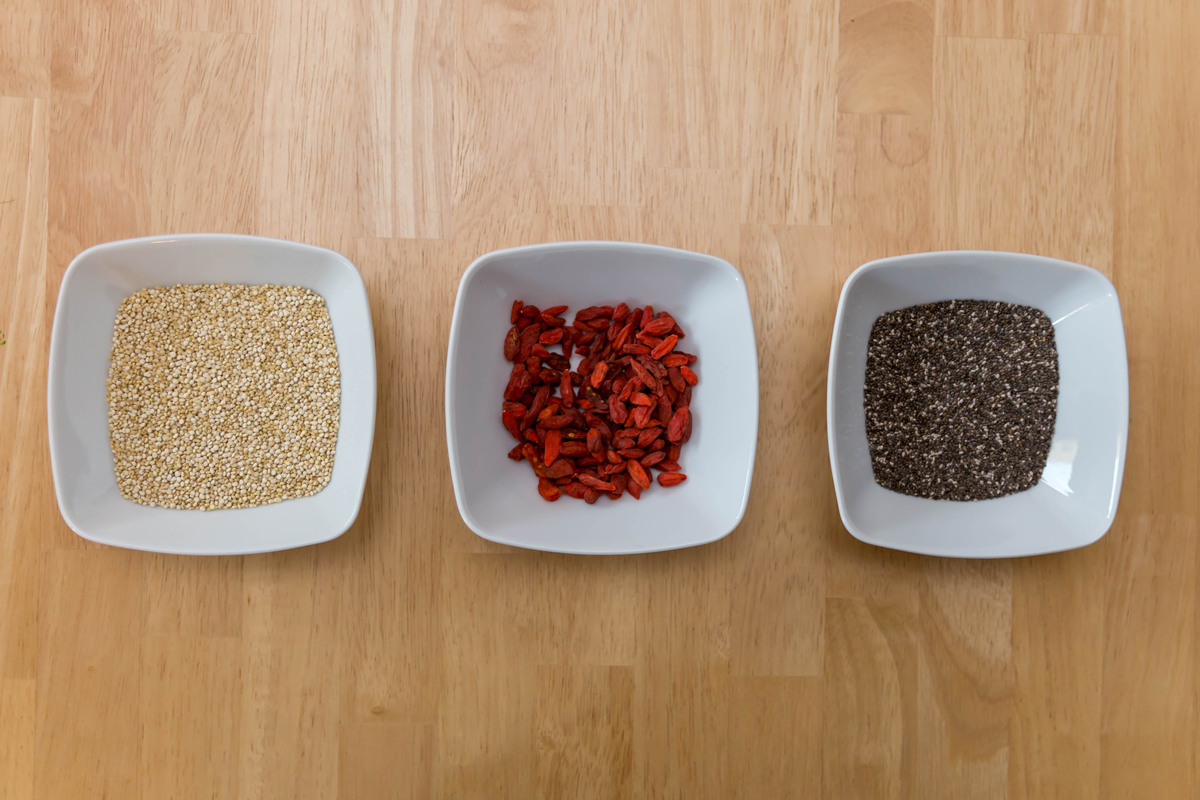
seeds
Marco Verch/Flickr, CC BY 2.0
When you look for a lunchtime snack or ingredients for a family meal, do you choose to include ‘superfoods’? In the past few years, relentless marketing has helped to make exotic products such as chia seeds, goji berries and avocados very popular. Superfoods are presented in the media as extremely nutritious and having a positive impact on health – but what exactly are ‘superfoods’, and is the hype justified? In fact, there is no clear definition of the term, and such foods often command very high prices while lacking scientific evidence for any real health benefit (Van den Driessche, Plat & Mensin, 2018).
We wanted to encourage students to reflect on the idea of superfoods, as young people play a significant role in influencing the food-buying choices of the whole family. We developed some simple experiments to allow students to analyse the nutritional content of selected superfoods for themselves, and to compare these foods to conventional, less expensive alternatives. In this way, we hope also to empower students to be media-literate citizens and critical consumers who understand the effect of advertising claims.
In this article, we focus on the ‘superfoods’ goji berry juice and chia seeds, which are analysed with regard to specific nutrients using qualitative and quantitative methods.
| Berries | Blueberries Cranberries Goji berries |
| Seeds | Chia seeds Hemp seeds Quinoa |
| Other | Garlic Ginger Chillies Bee pollen Spirulina Wheat grass |
The activities are suitable for students from around age 16, although the quantitative analysis may require some more advanced knowledge of chemistry.
Safety note
For all the experiments, students should wear safety glasses and follow the usual safety rules for chemistry classes.
Activity 1: Comparing goji berry juice and orange juice
Goji berries and their juice are often associated with an extremely high vitamin C content. But is drinking goji berry juice better than the good old habit of a glass of orange juice for breakfast, given that the goji juice is much more expensive? In this activity, the ascorbic acid (vitamin C) content of the two juices is compared in a qualitative way using ascorbic acid test strips.
This activity takes about 10 minutes.
Materials
- Orange juice
- Goji berry juice
- Two beakers (50 ml)
- Ascorbic acid test strips (we used the Quantofix® strips by Macherey-Nagel)
Procedure
- Put about 20 ml of the orange juice into one beaker, and a similar amount of goji juice into the other beaker.
- Take an ascorbic acid test strip and hold it in the orange juice for about 10 seconds. Make sure that the test field is completely submerged in the liquid.
- Take out the test strip and wait for another 30 seconds.
- Now compare the colour of the test field with the scale on the packaging. What can you conclude?
- Carry out the test with the goji juice in the same way.
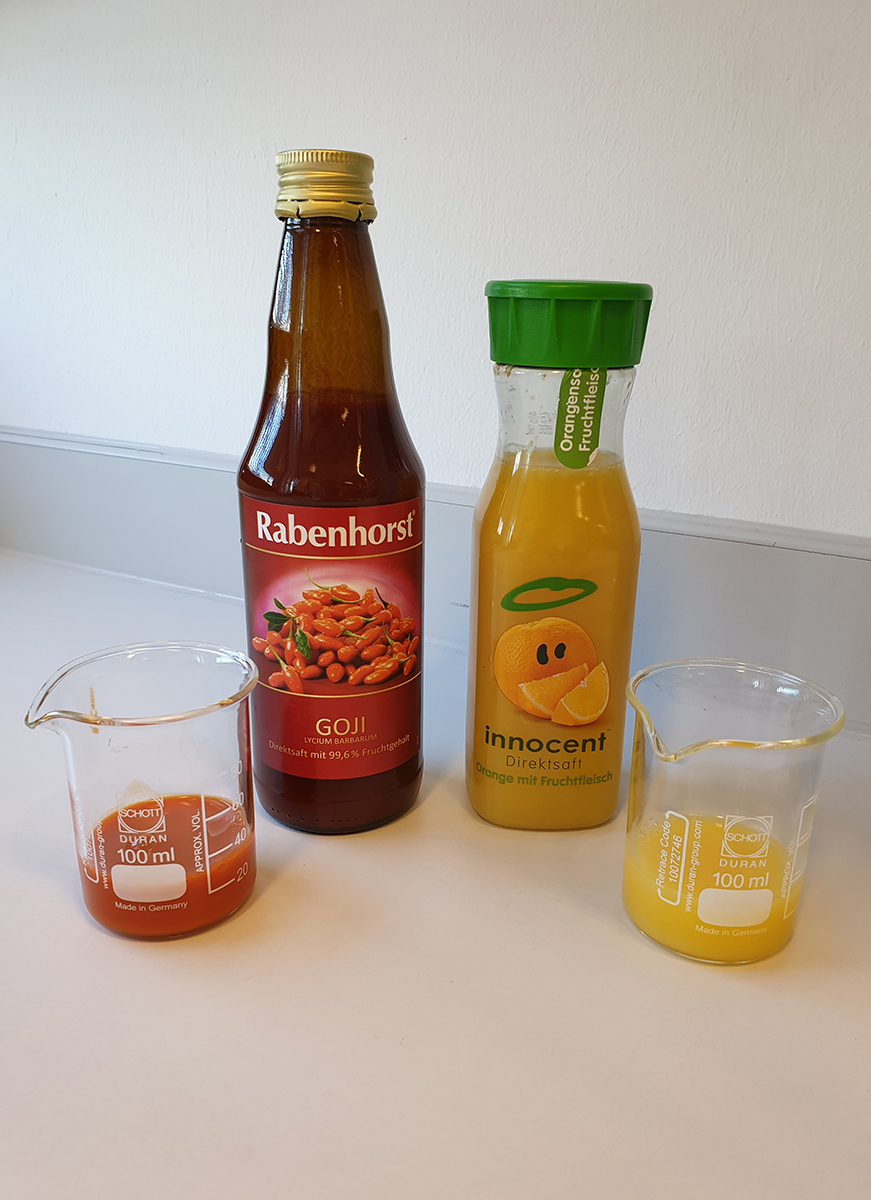
Nadja Frerichs
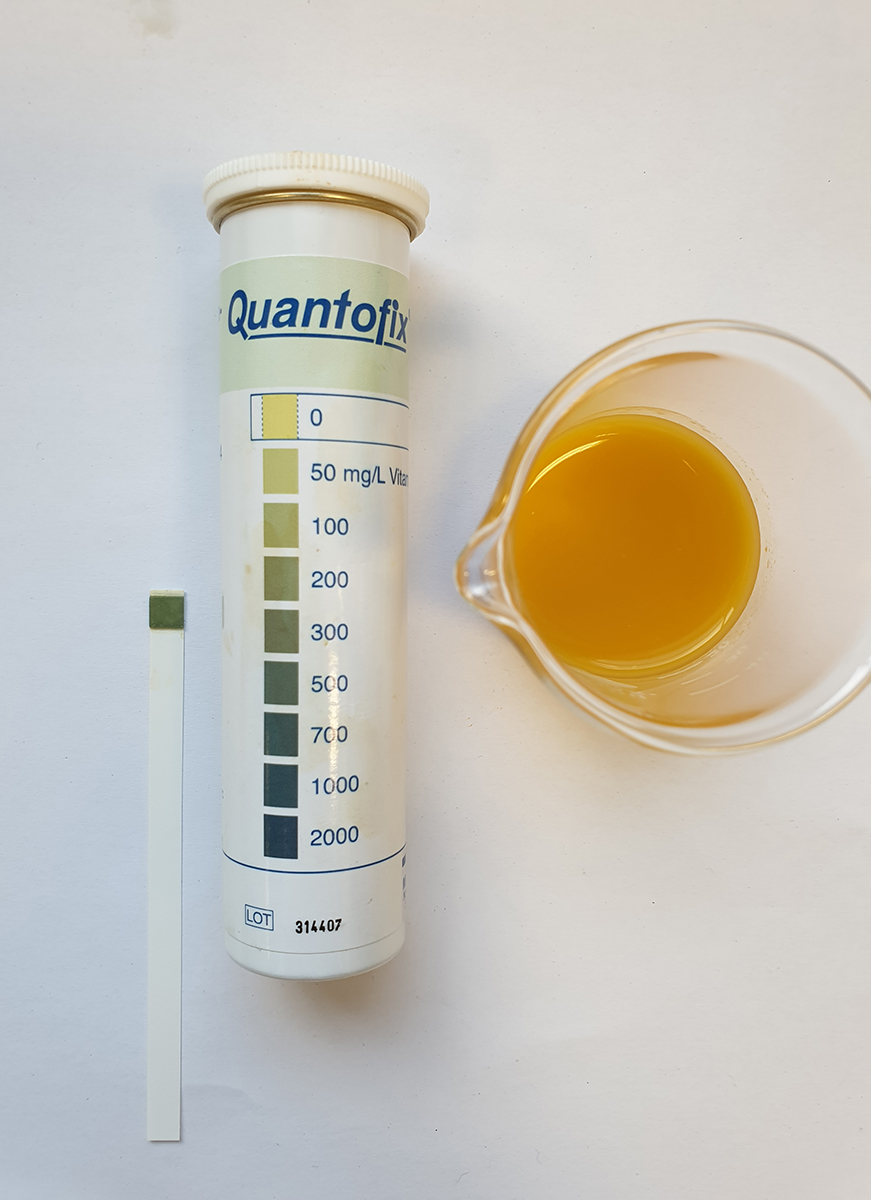
Nadja Frerichs
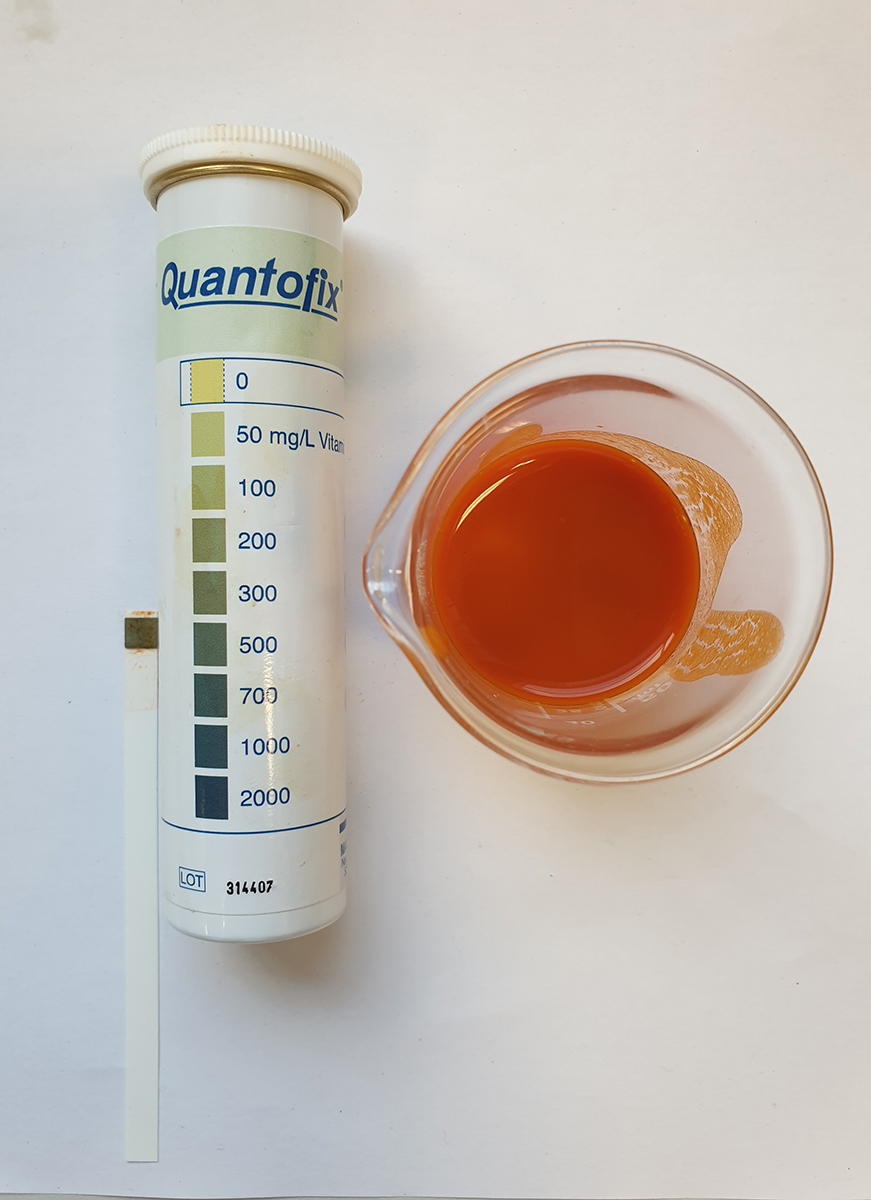
Nadja Frerichs
Results
The test strip results show the approximate concentration of vitamin C in each juice. In the orange juice, the test strip turns green, showing that this juice contains quite a high concentration of vitamin C, so it is a good source of this vitamin. Goji juice makes the test strip turn a darker green, showing that this juice contains more vitamin C than orange juice.
In the next activity, students use a titration method to measure the vitamin C concentration in each juice accurately and compare this to the recommended daily requirement.
Activity 2: Quantitative analysis of vitamin C in juice
From activity 1 we know that both goji berry juice and orange juice contain vitamin C – but which juice is a better choice to meet our daily need for vitamin C?
Titration with 2,6-dichlorophenolindophenol sodium solution is a common procedure to detect the amount of ascorbic acid. One mole of (anhydrous) 2,6-dichlorophenolindophenol sodium reacts with one mole of ascorbic acid, and the solution changes initially from light blue to colourless, and then from colourless back to light blue at the end point (once all the ascorbic acid has reacted). As the ascorbic acid is constantly oxidised by oxygen in the air, oxalic acid is added to prevent this.
This activity takes about 45 minutes (plus 15 minutes of preparation time for the solutions).
Materials
- Orange juice
- Goji berry juice
- Oxalic acid solution (2% w/w)
- 2,6-dichlorophenolindophenol sodium solution (0.001 mol/l)
- Measuring cylinders (two 10 ml and one 20 ml)
- Beakers (100 ml)
- Burette (secured with a clamp stand)
- Funnel
- Magnetic plate with a stirrer
Procedure
- Place 50 ml of the 2,6-dichlorophenolindophenol sodium solution in the burette.
- Use the funnel and measuring cylinders to pour 10 ml of orange juice, 20 ml of oxalic acid solution and the stirrer into a beaker.
- Place the flask and contents on the magnetic plate, so that the burette opening is just above the beaker. Switch on the stirrer.
- Note the volume of the solution in the burette (V1), then slowly and carefully open the burette and start the titration.
- As soon as you see a colour change in the flask, stop the titration and note the volume of solution in the burette again; this is V2.
- Carry out the same steps with the goji berry juice. You may need to refill the burette before the end point is reached.
- After the experiment, the solutions should be disposed of in a sealed container for solutions containing organic compounds.
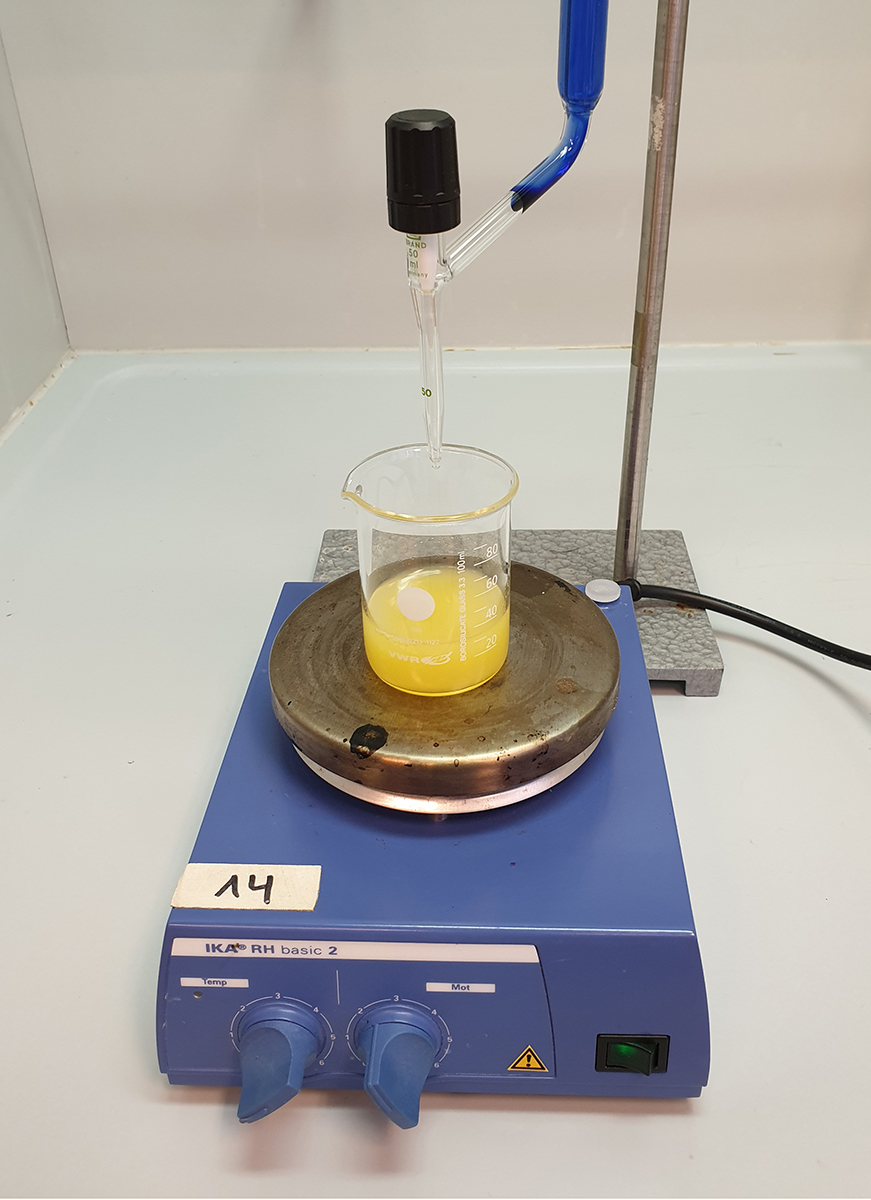
Nadja Frerichs
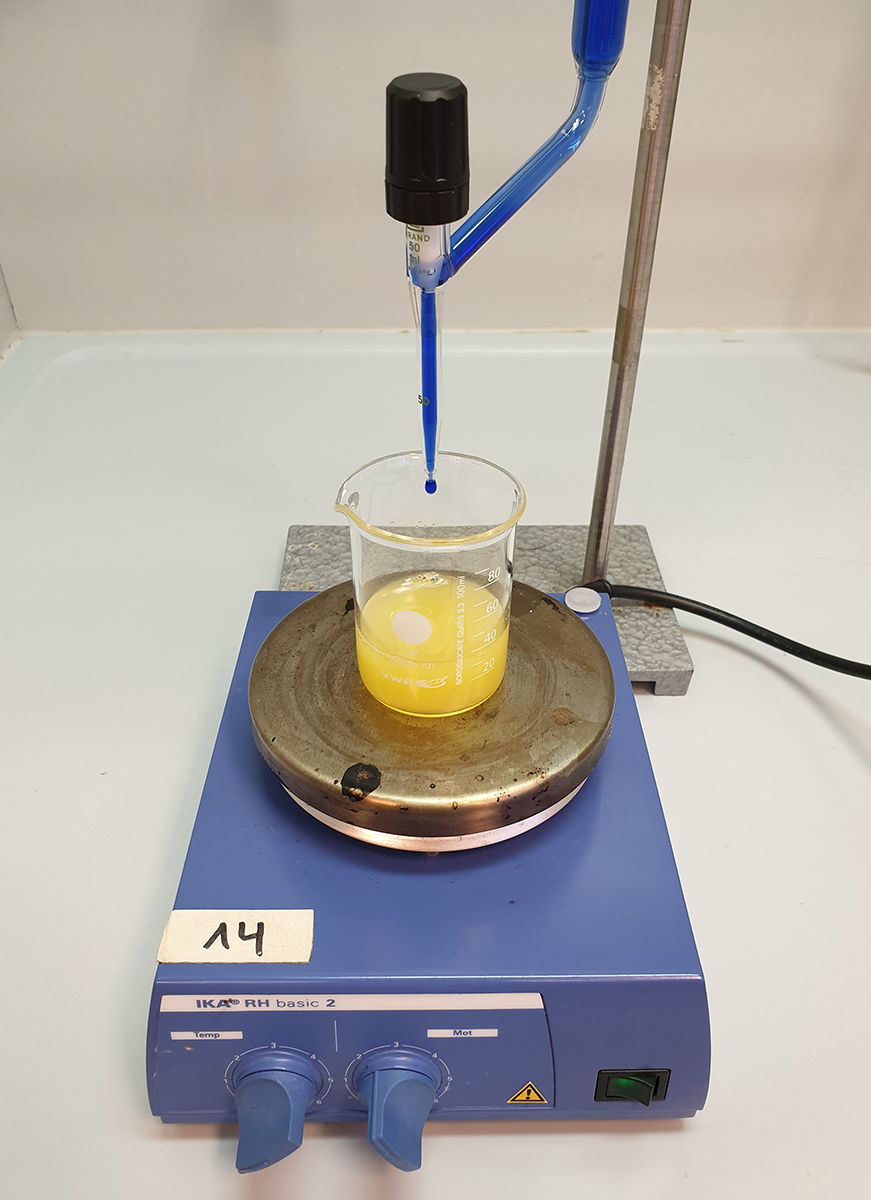
Nadja Frerichs
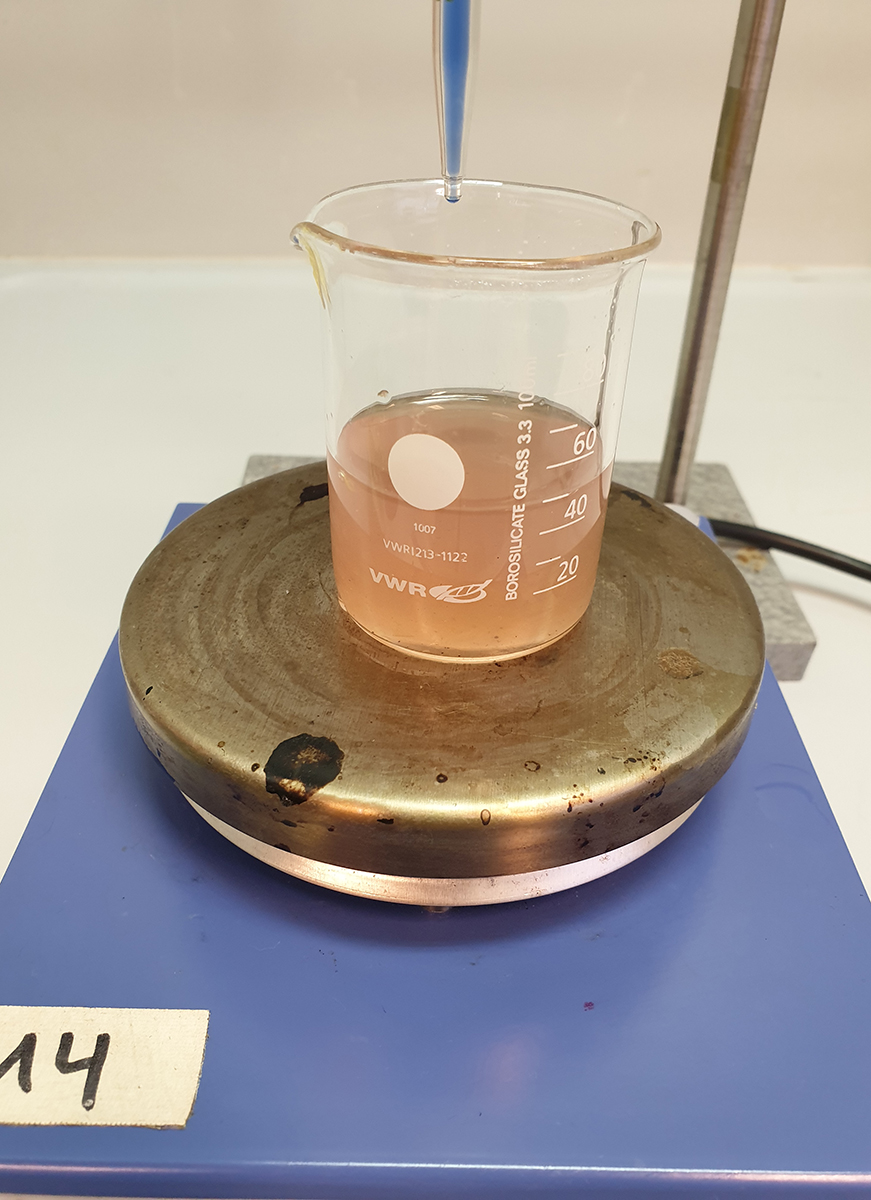
Nadja Frerichs
Calculation
In this calculation, we work out how much vitamin C is in 100 ml of each juice (enough for a small glass).
In our experiments, we found that 28 ml of 2,6-dichlorophenolindophenol sodium solution was needed to react with 10 ml of orange juice, and 58 ml was needed to react with 10 ml of goji berry juice. In the calculation below, we use these figures as examples, but students should replace these figures with those from their own experimental results.
Calculation for orange juice:
Vtotal = V1 – V2 = 50 ml – 22 ml = 28 ml
Here, one mole of 2,6-dichlorophenolindophenol sodium reacts with one mole of ascorbic acid.
Thus, 1 ml of the 0.001M 2,6-dichlorophenolindophenol sodium solution reacts with 0.176 mg of ascorbic acid (relative molecular mass of ascorbic acid = 176).
So 28 ml of the 0.001M 2,6-dichlorophenolindophenol sodium solution reacts with 0.176 mg x 28 of ascorbic acid
= 4.93 mg
This is for 10 ml of juice, so 100 ml of orange juice contains 49.3 mg of vitamin C.
Calculation for goji berry juice:
Vtotal = V1 – V2 = 70 ml – 12 ml = 58 ml
Thus, 1 ml of the 0.001M 2,6-dichlorophenolindophenol sodium solution reacts with 0.176 mg of ascorbic acid.
So 58 ml of the 0.001M 2,6-dichlorophenolindophenol sodium solution reacts with 0.176 mg × 58 of ascorbic acid
= 10.21 mg
This is for 10 ml of juice, so 100 ml of goji berry juice contains 102.1 mg of vitamin C.
For a large glass (300 ml) of each juice, the amount of vitamin C is:
Orange: 49.3 × 3 = 147.9 mg
Goji berry: 102.1 × 3 = 306.3 mg
Discussion
In Germany, one litre of goji berry juice costs around €15, while orange juice is available for less than €1 per litre. The daily need for vitamin C is about 75–100 mg (depending on age, weight, and other factors). A large glass (300 ml) of orange juice has about 150 mg of vitamin C, which is already some 30% more than the daily requirement. So, it is not necessary to drink goji berry juice for its even greater amount of vitamin C.
Of course, other positive effects of goji berry juice have been suggested, such as the antioxidative effect, but so far these benefits have not been established in humans (Kulczyński & Gramza-Michałowska, 2016).
Activity 3: Detecting proteins in seeds
This activity compares the protein content of linseeds (flax seeds) with ‘superfood’ chia seeds.
Proteins are an important part of a balanced diet, especially for people with an active lifestyle. There are many ‘high-protein’ products on the market – for example, breakfast cereals enriched with linseeds or the much more expensive chia seeds. Do these products really contribute to a protein-rich diet?
This activity uses the biuret reaction to test for the presence of protein. In the reaction, a purple colour is seen when protein is present, due to copper ions forming a coloured complex with proteins.
The activity takes about 30 minutes, plus 15 minutes of preparation time for the solutions.
Materials
- Chia seeds
- Linseeds (flax seeds)
- Milk (as control)
- Distilled water
- Sodium hydroxide solution (1 mol/l)
- Copper(II) sulfate solution (7% w/w)
- Weighing scales
- Test tube stand and 4 test tubes with stoppers
- 2 pipettes (5 ml)
- Dripping pipette
- 2 × mortar and pestle
Procedure
- Weigh out 0.5 g each of chia seeds and flax seeds, and grind these up separately using the mortars and pestles.
- Put the crushed seeds into separate test tubes and add 5 ml of distilled water to each.
- Seal the test tubes with the stoppers and shake them well.
- Pour 5 ml of milk into the third test tube and 5 ml of distilled water into the fourth test tube.
- Add 10 drops of the copper(II) sulfate solution to each of the four test tubes.
- Pipette 1 ml of sodium hydroxide solution into each test tube.
- Shake the test tubes to mix the contents well.
- Note your observations: you should see some colour changes.
- After the experiment, dispose of the solutions in a sealed container for solutions containing heavy metals.
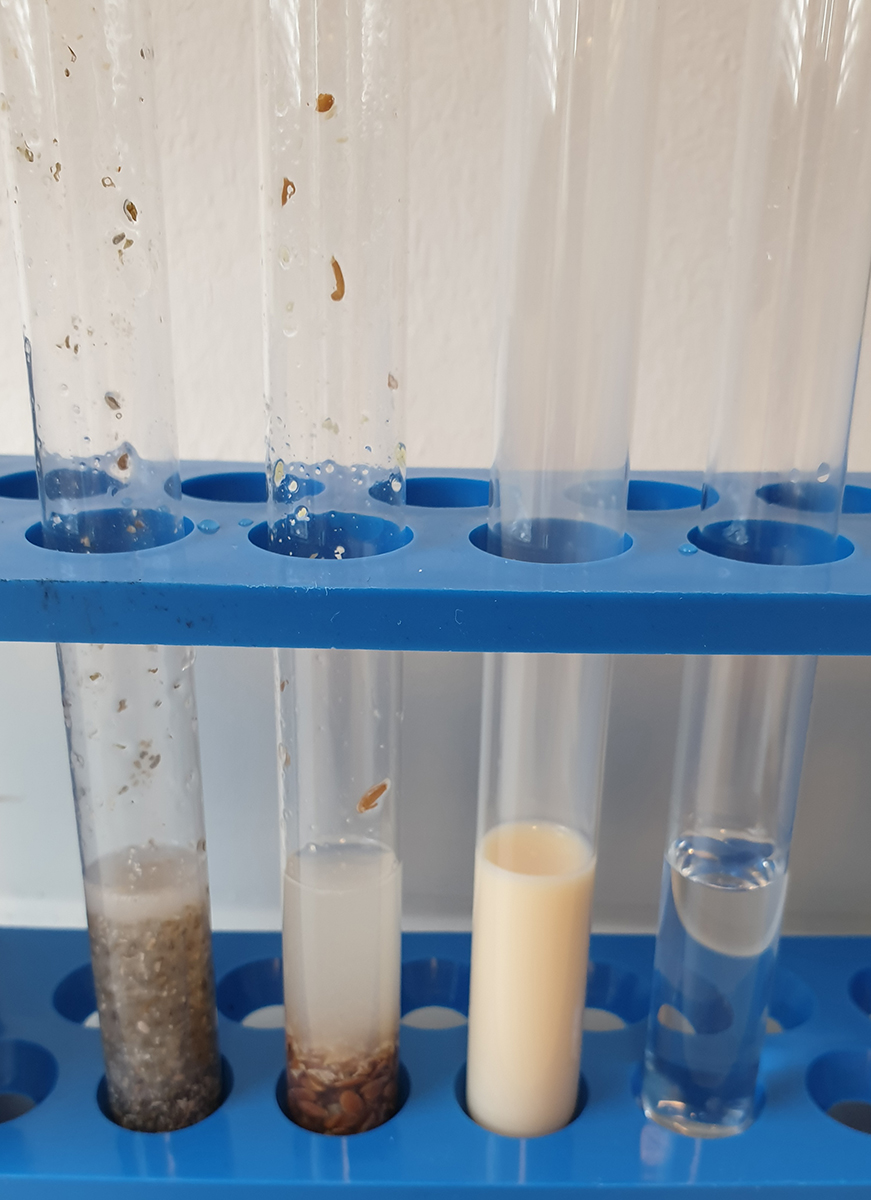
Nadja Frerichs
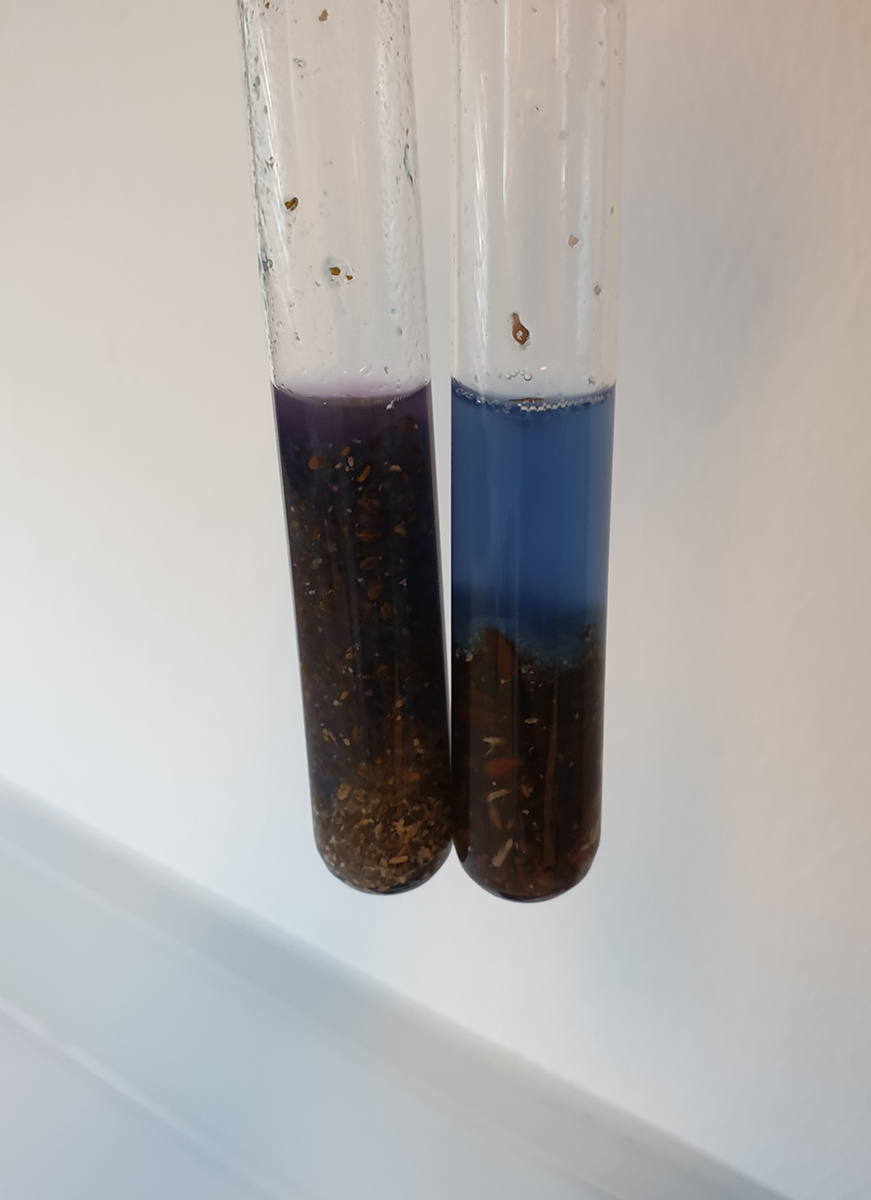
Nadja Frerichs
Results and discussion
The expected results are shown in table 2.
| Test tube contents | Colour change |
|---|---|
| Milk (control) | Purple |
| Water (control) | Light blue |
| Chia seeds | Purple |
| Linseeds, flax seeds | Purple |
Milk contains protein, so the milk solution turns purple. The chia seed and linseed mixtures also turn purple, so both types of seed must also contain protein. Students may notice that the purple coloration is more intense in the chia sample, showing that these seeds contain a higher concentration of protein.
Proteins can improve muscle growth and contribute to a balanced diet, but is it necessary to pay more for chia seeds? Note that the recommended daily amount of protein for an adult is around 0.8–1 g per kg of body weight (Rodriguez, 2015) – that is, around 48 g per day for a 60 kg person. So, at these quantities, it is quite easy for anyone to consume enough protein just by eating a balanced diet including normal foods that are rich in protein.
Chia seeds are also thought to be extremely healthy due to other nutrients, especially unsaturated fats. In addition, in the media you can find advice that eating chia seeds produces a feeling of being full for longer, and therefore potentially helps weight loss, because the seeds expand when put into liquid, producing a gelatinous ‘chia pudding’. However, so far, no studies confirm either the nutritional benefits or the weight loss effects of chia seeds (Ulbricht et al., 2009; Egras et al., 2011).
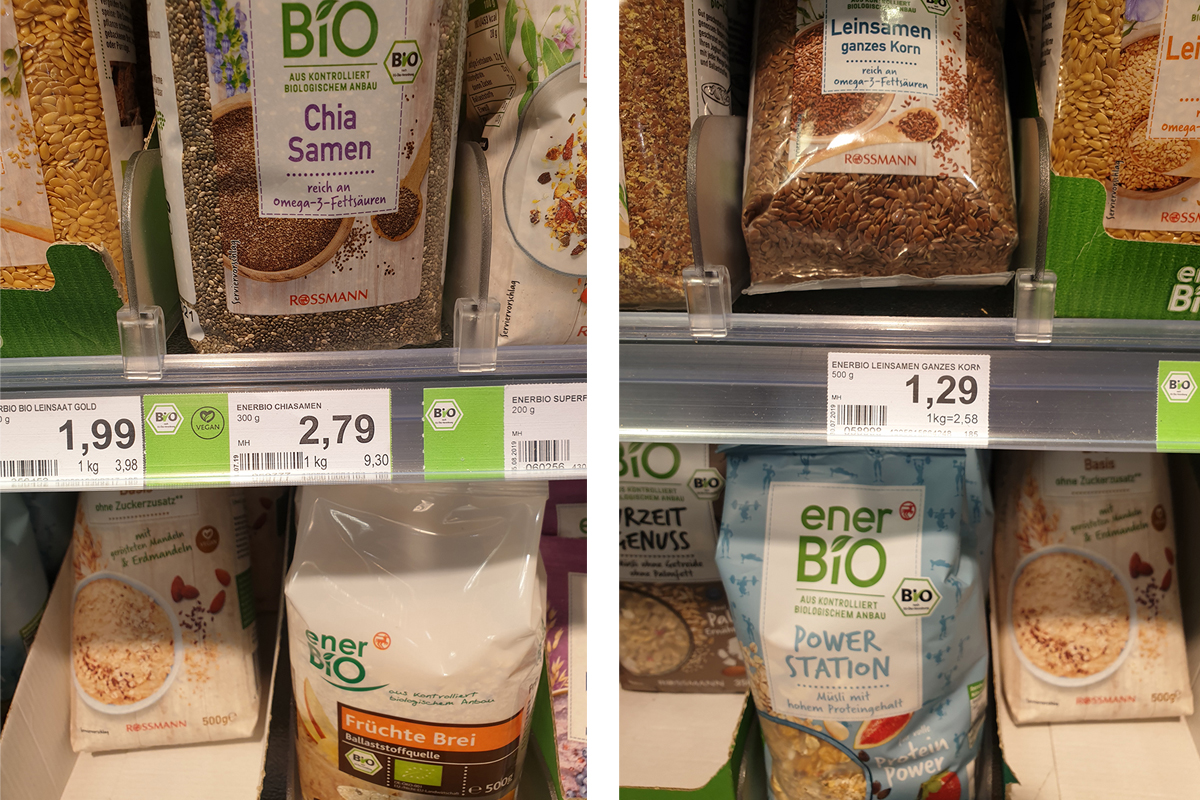
Nadja Frerichs
Conclusions
From the results of these experiments the students can conclude that, in many cases, non-exotic, less expensive, perhaps locally sourced alternatives may be quite sufficient to meet the daily needs for nutrients and maintain a healthy diet. For most superfoods, no studies on humans confirm the potential health benefits. Rather, a diet that is balanced overall is the key to healthy nutritional habits.
The activities could be followed up by a classroom discussion on the ethical and ecological aspects of superfoods. For example, the excessive cultivation of avocados leads to huge amounts of pesticides being released to the environment, and long transportation routes from South America impact the environment. A social aspect is that the popularity of certain products (e.g. quinoa) in developed countries leads to rising prices in their countries of origin (in this case mostly Chile and Bolivia), where people are no longer able to afford their staple foods. Such discussions could lead to the question of sustainable nutrition, and to education for sustainable development.
References
- Egras AM et al. (2011) An evidence-based review of fat modifying supplemental weight loss products. Journal of Obesity 2011: 297315. doi: 10.1155/2011/297315
- Kulczyński B, Gramza-Michałowska A (2016) Goji berry (Lycium barbarum): composition and health effects – a review. Polish Journal of Food and Nutrition Sciences 66: 67-75. doi: 10.1515/pjfns-2015-0040
- Rodriguez NR (2015) Introduction to Protein Summit 2.0: continued exploration of the impact of high-quality protein on optimal health. The American Journal of Clinical Nutrition 101: 1317S-1319S. doi: 10.3945/ajcn.114.083980
- Ulbricht C et al. (2009) Chia (Salvia hispanica): a systematic review by the Natural Standard Research Collaboration. Reviews on Recent Clinical Trials 4(3): 168-174. doi: 10.2174/157488709789957709
- van den Driessche JJ, Plat J, Mensink RP (2018) Effects of superfoods on risk factors of metabolic syndrome: a systematic review of human intervention trials. Food & Function 9: 1944-1966. doi: 10.1039/C7FO01792H
Resources
- A comprehensive and accessible overview of superfoods from the Harvard T H Chan School of Public Health can help spark classroom discussion.
- An article from the Harvard Medical School highlights some less exotic foods that can provide some important nutrients to enhance a healthy diet.
Review
This article and its experiments will provide teachers and students with the skills to analyse and compare some important components within different kinds of foods. Analysing food items through laboratory experiments allows students to assess their nutritional value for themselves, and to investigate whether the description ‘superfood’ is deserved. However, the experiments can be used for many different foods, not just ‘superfoods’.
The article also encourages students to combine nutritional information with laboratory experiments, which helps to develop their skills of scientific analysis and critical thinking more broadly.
Dr Bartolomé Pizà Mir, science teacher, Sant Vicenç de Paül, Sóller, Spain





